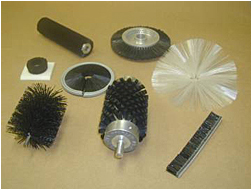Nylon Brushes
 Nylon brushes are any of the brush constructions that are available, filled with nylon filaments. Nylon filaments can be put in cylinder, cup, wheel or block brushes and can be used with any of the constructions. Metlkor, wound, staple set, epoxy set, channel strip, wire drawn, or twisted-in-wire. (See products section on our web site for information and sketch blanks)
Nylon brushes are any of the brush constructions that are available, filled with nylon filaments. Nylon filaments can be put in cylinder, cup, wheel or block brushes and can be used with any of the constructions. Metlkor, wound, staple set, epoxy set, channel strip, wire drawn, or twisted-in-wire. (See products section on our web site for information and sketch blanks)
Nylon is the most widely used fill material for brushes. It is the longest lasting and most versatile brush fill material. Nylon far out wares any of the other fill materials in most applications. Nylon has very good chemical resistance and a high stiffness modulus. Nylon will absorb some moisture thus reducing stiffness. The stiffness can be recovered by increasing the diameter of the filament. Relative stiffness of nylon filaments in a brush is directly related to the diameter of the filament and inversely related to the length of the filament in the formula: relative stiffness = diameter squared over length cubed. (RS=D²/L³)
The main factors that effect brush wear are: bend recovery, abrasion resistance, filament size, brush speed and fatigue resistance.
| Inherent Bend Recovery Chart | |
|---|---|
| (Standard Test) | |
| Material | Bend Recovery (%) |
| Nylon 6,12 | 92 |
| Nylon 6,6 | 90 |
| Hog Bristle | 92 |
| Horse Hair | 88 |
| Tampico | 40 |
| Polystyrene | 35 |
| Polypropylene | 75 |
| Polyvinylchloride-Polyvinyl Acetate | 50 |
| Polyvinylidene Chloride | 82 |
Bend recovery is the ability of a nylon filament to flex and then return to its original position. Bend recovery of a brush fill material is partly an inherent property of that material and partially influenced by manufacturing techniques.
| Abrasion Rate Chart | ||
|---|---|---|
| Material | mg*/hour | Abrasion Ratio ** |
| Nylon 6,12 | 40 | 1.00 |
| Nylon 6,6 | 46 | 1.15 |
| Hog Bristle | 160 | 4.00 |
| Horse Hair | 165 | 4.13 |
| Tampico | 220 | 5.50 |
| * 1 mg = 0.001 gram
** Based on Nylon 6,12 = 1 |
||
Abrasion rate of a brush filling material is primarily an inherent property of that material. In the case of synthetic filaments, it is essentially a property of the material from which the filament is made of. It is only slightly influenced by the process of filament manufacturing.
Brush speed as expected affects brush life. Abrasion rate increases as speed increases. This is caused by the fact the more times the nylon filament comes in contact with what is being brushes the more times it impacts and flexes the quicker it wears.
| Inherent Fatigue Resistance Chart | |
|---|---|
| (Standard Test) | |
| Material | Fatigue Resistance (%) |
| Nylon 6,12 | 98 |
| Nylon 6,6 | 90 |
| Hog Bristle | 40 |
| Horse Hair | 10 |
| Tampico | 10 |
| Polypropylene | 98 |
| Polystyrene | 30 |
| Polyvinylidene Chloride | 20 |
| Polyurethane | <5 |
| Polyvinylchloride | <5 |
Fatigue resistance is a measure of a materials resistance to breaking, splitting, or complete fracture. After many cycles of flexing fatigue failure begins as a small crack and grows with each additional flexing until it breaks.

